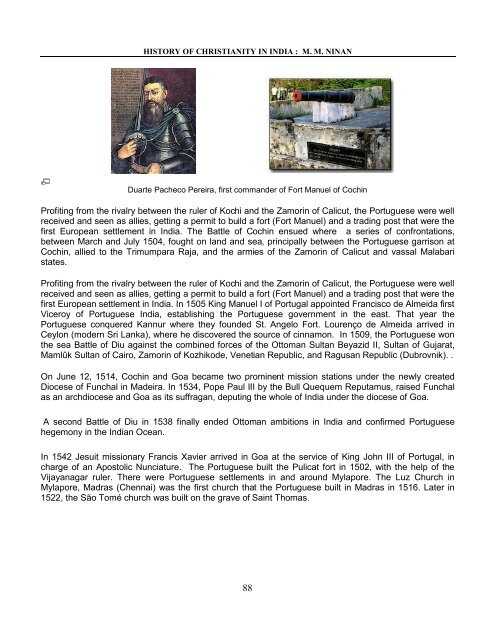Indian Christianity
Create successful ePaper yourself
Turn your PDF publications into a flip-book with our unique Google optimized e-Paper software.
HISTORY OF CHRISTIANITY IN INDIA : M. M. NINAN<br />
Duarte Pacheco Pereira, first commander of Fort Manuel of Cochin<br />
Profiting from the rivalry between the ruler of Kochi and the Zamorin of Calicut, the Portuguese were well<br />
received and seen as allies, getting a permit to build a fort (Fort Manuel) and a trading post that were the<br />
first European settlement in India. The Battle of Cochin ensued where a series of confrontations,<br />
between March and July 1504, fought on land and sea, principally between the Portuguese garrison at<br />
Cochin, allied to the Trimumpara Raja, and the armies of the Zamorin of Calicut and vassal Malabari<br />
states.<br />
Profiting from the rivalry between the ruler of Kochi and the Zamorin of Calicut, the Portuguese were well<br />
received and seen as allies, getting a permit to build a fort (Fort Manuel) and a trading post that were the<br />
first European settlement in India. In 1505 King Manuel I of Portugal appointed Francisco de Almeida first<br />
Viceroy of Portuguese India, establishing the Portuguese government in the east. That year the<br />
Portuguese conquered Kannur where they founded St. Angelo Fort. Lourenço de Almeida arrived in<br />
Ceylon (modern Sri Lanka), where he discovered the source of cinnamon. In 1509, the Portuguese won<br />
the sea Battle of Diu against the combined forces of the Ottoman Sultan Beyazid II, Sultan of Gujarat,<br />
Mamlûk Sultan of Cairo, Zamorin of Kozhikode, Venetian Republic, and Ragusan Republic (Dubrovnik). .<br />
On June 12, 1514, Cochin and Goa became two prominent mission stations under the newly created<br />
Diocese of Funchal in Madeira. In 1534, Pope Paul III by the Bull Quequem Reputamus, raised Funchal<br />
as an archdiocese and Goa as its suffragan, deputing the whole of India under the diocese of Goa.<br />
A second Battle of Diu in 1538 finally ended Ottoman ambitions in India and confirmed Portuguese<br />
hegemony in the <strong>Indian</strong> Ocean.<br />
In 1542 Jesuit missionary Francis Xavier arrived in Goa at the service of King John III of Portugal, in<br />
charge of an Apostolic Nunciature. The Portuguese built the Pulicat fort in 1502, with the help of the<br />
Vijayanagar ruler. There were Portuguese settlements in and around Mylapore. The Luz Church in<br />
Mylapore, Madras (Chennai) was the first church that the Portuguese built in Madras in 1516. Later in<br />
1522, the São Tomé church was built on the grave of Saint Thomas.<br />
88


















